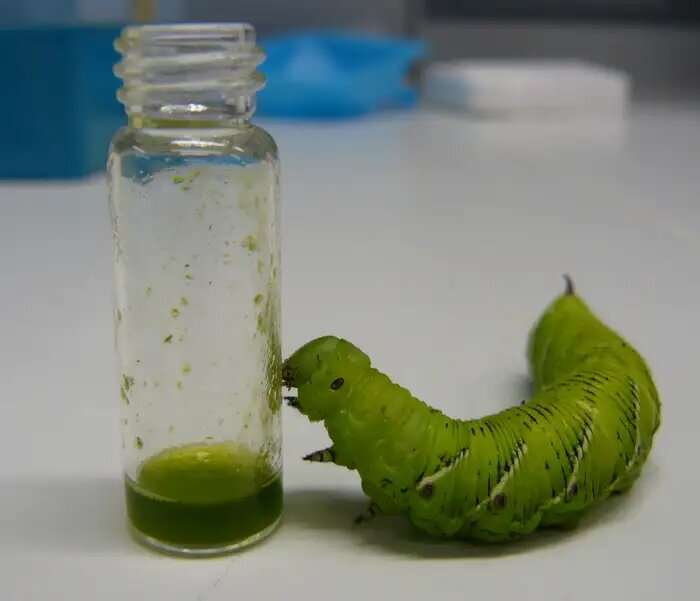This article has been reviewed according to Science X's editorial process and policies. Editors have highlighted the following attributes while ensuring the content's credibility:
fact-checked
peer-reviewed publication
trusted source
proofread
Architects of their own destruction: Why do tobacco hornworm caterpillars attract their own predators?

The relationship between caterpillars and plants is incredibly complex and can give rise to fascinating mysteries. One such conundrum involves tobacco hornworm caterpillars and their interaction with the plants on which they feed, which seems, at first glance, to make no sense. Why do these caterpillars cause the plant they are feeding on to send signals which attract their natural predators? Scientists at the University of Amsterdam have now been able to provide new insights into this unusual connection. Their research was published today, June 28, in Nature Communications.
Plants constantly release fragrances into the air, and these so-called volatile compounds carry important information about the status and physiology of the plant which can be used by both friends and foes in its vicinity. Previous studies had shown that when tobacco hornworm caterpillars feed on tobacco plants the fragrances the plant releases become more attractive to one of caterpillar's natural enemies: Geocoris spp., commonly known as big-eyed bugs.
This phenomenon naturally benefits the plant by attracting predators that help control the caterpillar population. Contrary to expectations, however, the study revealed that the modification of the plant's fragrance is not a cry-for-help signal emitted by the plant itself, but rather the result of an enzyme introduced into the plant wounds by the caterpillar itself during feeding.
"We were initially perplexed by the observation that the caterpillars essentially betray themselves by making the plant's volatile bouquet more alluring to a natural enemy. This led us to investigate potential beneficial roles that this caterpillar enzyme may have for the insect itself," says Yu-Hsien Lin, first author of the new study.
In their new publication, the researchers provide a comprehensive explanation for this puzzling phenomenon. They have identified an enzyme—called hexenal isomerase—in the caterpillar's saliva and confirmed its ability to modify the volatile profile of plants. To further validate their findings, the researchers created mutant caterpillars that were unable to produce the enzyme.
Remarkably, these mutants exhibited severe developmental impairments: they took longer to develop into adults and had lower pupal weights (the measure of their mass during the transformation from caterpillar to moth). The hexenal isomerase-deficient adults also displayed more physiological deformities, such as wings that didn't fully open. These discoveries indicate that the hexenal isomerase enzyme plays a crucial role in the healthy development of tobacco hornworms.
"Our study sheds light on why these caterpillars produce an enzyme that attracts their own predators, and why evolution has not eliminated this seemingly counterproductive trait. We have discovered that the enzyme, besides modifying plant fragrances, likely serves a vital or beneficial function in the caterpillar's development, outweighing any costs associated with its interaction with the plant," says team leader Silke Allmann.
More information: Yu-Hsien Lin et al, A salivary GMC oxidoreductase of Manduca sexta re-arranges the green leaf volatile profile of its host plant, Nature Communications (2023). DOI: 10.1038/s41467-023-39353-0
Journal information: Nature Communications
Provided by University of Amsterdam


















